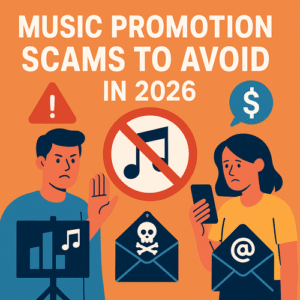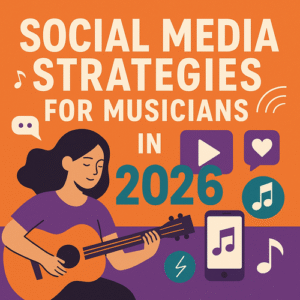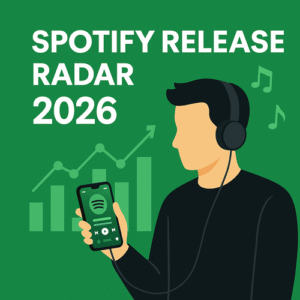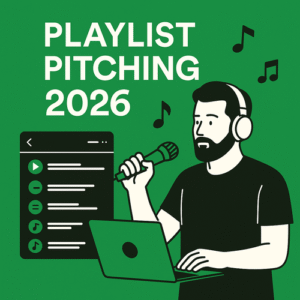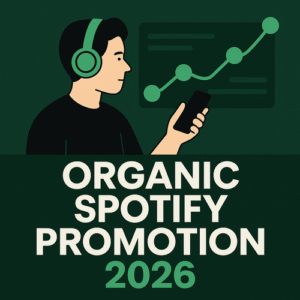Spotify’s algorithm has always been one of the most mysterious — and powerful — forces in the modern music industry. For independent artists, understanding how it works is like having a roadmap to exposure. In 2026, Spotify’s algorithm has evolved even further, combining artificial intelligence, listening behavior, and emotional data to recommend the right song to the right listener at the perfect moment.
If you learn how to work with the algorithm instead of against it, you can unlock consistent growth, get featured on algorithmic playlists, and build a steady audience without spending thousands on ads.
Let’s dive into how it all works — and how to use it to your advantage.
What the Spotify Algorithm Actually Does
Spotify’s algorithm analyzes billions of data points every day. Every stream, skip, playlist add, and save sends signals about how people interact with music. Based on this behavior, Spotify decides which tracks to recommend next.
The algorithm’s main goal is simple: keep listeners engaged. The more people stay on the platform, the more valuable Spotify becomes. That means artists who keep listeners hooked get rewarded with higher visibility.
For artists, this is an opportunity — because if you understand what Spotify values, you can align your release strategy accordingly.
The Main Data Points Spotify Uses in 2026
In 2026, Spotify’s algorithm tracks more than ever before. Here are the most important signals:
- Skip Rate: How often listeners skip your song before the 30-second mark. A high skip rate hurts you.
- Completion Rate: How many people listen to the end. A high completion rate boosts your visibility.
- Saves: When users save your song to their library — a major positive signal.
- Playlist Adds: When fans add your track to personal playlists, it tells Spotify your song has long-term value.
- Repeat Plays: When someone listens multiple times, it signals deep connection.
- Social Engagement: Sharing your Spotify link on other platforms (TikTok, Instagram, YouTube) now directly influences visibility.
The more positive signals your track receives, the more likely Spotify is to push it to algorithmic playlists like Discover Weekly, Release Radar, and Radio.
The Algorithm’s Two Phases of Discovery
Spotify’s recommendation process works in two major phases:
Phase 1: Testing.
When you release a new track, Spotify first shows it to a small group — your followers and a few related listeners. It watches how they react. If they skip quickly, engagement stops there. But if they save, replay, or listen to the end, Spotify moves to phase two.
Phase 2: Expansion.
Once Spotify confirms that people enjoy your track, it expands your reach to new audiences. That’s how songs end up on Discover Weekly or Daily Mix for listeners who’ve never heard of you.
Your job is to create songs — and release strategies — that pass the testing phase.
How to Work With the Algorithm (Not Against It)
If you want to trigger Spotify’s algorithm in 2026, follow these best practices:
1. Optimize Your First 10 Seconds
Spotify measures engagement from the moment playback starts. Start strong — avoid long intros or slow build-ups. Capture emotion or rhythm instantly to keep listeners hooked.
2. Encourage Saves and Shares
Ask fans to save your song, not just stream it. Saves have more algorithmic weight than passive plays.
3. Maintain Consistent Releases
The algorithm favors active profiles. Artists releasing music regularly (every 4–6 weeks) tend to appear in Release Radar and Discover Weekly more often.
4. Use Data to Refine Your Sound
Spotify for Artists gives you detailed insights. Track where engagement drops and which songs perform best. Then, create new releases based on that listener data.
5. Avoid Fake Streams
Bot plays and “guaranteed streams” can destroy your algorithmic potential. Spotify identifies fake engagement easily — once flagged, your account can lose all playlist traction.
Boost Your Music with Daimoon.media
Daimoon.media is a leading music marketing agency based in Rotterdam, helping both emerging and established artists grow their presence on Spotify, YouTube, and SoundCloud. With a proven track record—over 10,000 artists served, 15 million YouTube views, and millions of playlist listeners—Daimoon.media delivers safe, organic, and fully tailored promotion campaigns for every genre.
The Hidden Power of Spotify’s AI in 2026
Spotify’s 2026 algorithm is powered by next-generation AI models that analyze more than just numbers — they analyze emotion. The system can now detect musical patterns like mood, tempo, and even lyrical sentiment to match songs with a listener’s emotional state.
For example, if a user often listens to melancholic acoustic songs late at night, the AI will start recommending similar emotional tones — including new artists that match that mood.
This means your song metadata, artwork, and release timing all contribute to how Spotify perceives and recommends your track.
The Role of Playlists in Algorithmic Growth
Playlists are still the most direct way to feed Spotify’s algorithm. When your song performs well on independent playlists with high engagement, Spotify recognizes the activity and starts recommending your music to similar listeners.
Here’s how it connects:
- Independent playlists bring first organic engagement.
- Algorithm sees high completion and save rates.
- Spotify automatically pushes your song into Discover Weekly and Radio playlists.
That’s why organic playlist promotion remains a critical part of algorithmic success — it’s how you “teach” Spotify who your audience is.
Social Media Integration and Off-Platform Signals
One of the biggest updates in 2026 is how Spotify’s algorithm reads off-platform activity. When people click Spotify links from social media (like TikTok or Instagram Reels), those external traffic spikes act as positive discovery signals.
This means cross-platform promotion isn’t just good marketing — it’s a technical advantage.
Artists who generate social buzz around their songs before release day see significantly higher algorithmic reach once the track goes live.
The 30-Second Rule Still Matters
Spotify only counts a stream after 30 seconds. But even beyond royalties, that first half-minute determines how your track performs algorithmically.
If listeners skip before the 30-second mark, Spotify assumes they weren’t interested — and reduces your track’s exposure.
That’s why songwriting and arrangement matter. Get to the hook faster, and keep your song’s energy consistent to maintain engagement.
What the Algorithm Rewards Most
In summary, the Spotify algorithm in 2026 rewards:
- Consistency in releases
- Real listener engagement (saves, replays, follows)
- Strong retention beyond 30 seconds
- Off-platform traffic from social media
- Organic growth from playlists
Every release is like a small data experiment. The more you refine your approach, the stronger your results get over time.
Common Myths About Spotify’s Algorithm
Myth #1: Paid promotion boosts algorithm ranking.
False. Spotify separates paid ads from organic algorithmic growth.
Myth #2: You need thousands of followers to get on Discover Weekly.
Also false. Even a few hundred engaged fans can trigger algorithmic placement if your engagement rates are high.
Myth #3: Longer songs perform better.
No — the algorithm doesn’t reward length. It rewards completion and replay value.
Myth #4: Genre doesn’t matter.
It does. Spotify categorizes your music by sound and listener habits. Staying consistent helps build algorithmic trust.
FAQ: Understanding Spotify’s Algorithm
1. How does Spotify decide who hears my song?
Through behavioral data — like saves, replays, skips, and playlist additions.
2. What’s the most important metric?
Save rate and completion rate are the strongest indicators of listener interest.
3. How often should I release music?
Every 4–6 weeks keeps your profile active and visible in Spotify’s system.
4. Do collaborations help with the algorithm?
Yes — they introduce your song to multiple fanbases, expanding engagement.
5. How long does it take to see results?
Typically 2–6 weeks after release, once Spotify’s system processes your engagement data.
